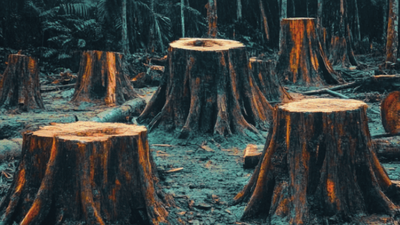ARTICLE AD BOX

By: Sridhar RadhakrishnanIt begins, as all civic tragedies do, with a complaint. A branch bending too close to a shop board. A root that lifts a pavement tile.Leaves falling on a car or clogging a drain. People say this is high risk during monsoon and so, somewhere in the municipal maze, a file is born.A tree becomes a threat and what follows is a slow, bureaucratic death march. The file drifts like a leaf in a gutter — through PWD, forest department and reaches the mayor’s desk. An official tree committee is formed to protect, advise and conserve trees but it acts as a tree axing committee.It merely okays the inevitable. No one visits the site or asks the ‘stakeholders’ (rain, birds or the vendors who cherished the shade).
Social forestry wing used to handle such matters with care, some sense of life beyond paperwork. Now there’s a faster route as one word unlocks every door: disaster.A healthy rain tree? ‘disaster risk’ A banyan with wandering roots? ‘potential hazard’. A huge peepal tree shading a junction? ‘emergency clearance’. The Disaster Management Act — meant for floods and cyclones — has become a convenient axe. When it is invoked, all safeguards vanish.
A process that once mandated inspection and consent now requires only a whisper — risk. The city must be made resilient and smart, but climate smart? No.
Just smart. And so, the cutting begins. Not pruning but punishment. Not management but mutilation. Men with saws and no knowledge of arboriculture arrive like stormtroopers.Their qualification is the noise they bring. They study the canopy the way a butcher studies the bone.
They cut where it is easiest, not where it is right. Branches fall like old memories. Soon the air is filled with a fine dust of former shade and grandmother rain trees, banyans, peepals, badams, each become a casualty in the war against shade.The aftermath is eerily consistent. Roads look wider, emptier and hotter. Birds circle once and vanish. The bus stop bakes. An old vendor writhes under the sun where the canopy once cooled her.
Officials record success in WhatsApp groups: ‘Swift action under Disaster Management Act — risk averted’.Some trees are lucky as they get a promise: 10 saplings will be planted elsewhere. Elsewhere, of course, is a myth — like heaven. This is how our cities operate — a choreography of speedy convenience and potentially stupid in the name of safety. In an age of climate crisis, we are cutting down our first line of defence against heat, pollution and flooding and terming it disaster management.Walk through Thiruvananthapuram, Kochi or Kozhikode — once archways of greenery are mere amputated avenues now. The ghosts of trees stand in rows, branches disfigured, roots suffocating under interlock tiles, trunks strangled with string lights. The air is hot and the streets seem more cruel. We have made our cities unlivable in the name of keeping them safe.And yet, in this bleak landscape, a few voices persist — like Tree Walk Trivandrum — a small, stubborn collective documenting every felled tree, every absurd order.
They remind us that trees are not decoration; they are living infrastructure that cools the city, holds its soil, sequesters its carbon while filtering its air. They do the work of an entire department, powered only by grief and persistence. But they fight an uphill battle.
For every tree they save, 10 more fall to some new ‘urgent’ order.The system rewards speed not sense. It doesn’t have to be this way. We desperately need a comprehensive Tree Act — a law that treats trees as ecological citizens, not urban furniture.
An Act with scientific pruning standards, certified arborists, accountability and proof before declaring a tree a ‘disaster’. A law that guarantees green cover for citizens and dignity for trees. Because this isn’t about sentimentality.
It’s about survival.Every tree we cut takes a piece of our resilience against heat, flood and despair. The more we replace shade with cement, the more we invite the disasters we claim to prevent. We have built a system that can sign a death warrant faster than a leaf can fall. We have learned to manage disasters by creating new ones. And what we leave behind are not just broken trees — but broken thinking. A quiet proof that our disaster is not what nature does to us —it’s what we do to her.(The writer is an environmentalist and policy analyst working on issues of agriculture, biodiversity and climate)

 1 day ago
7
1 day ago
7









 English (US) ·
English (US) ·